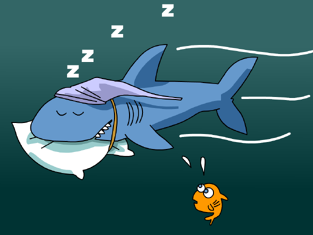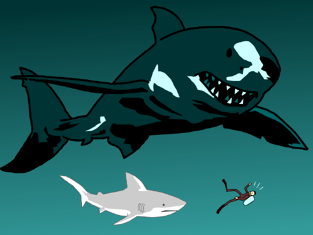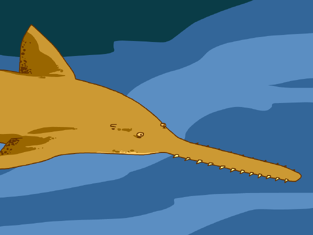| Sharks | |||
|---|---|---|---|
 | |||
| Season | 17 | ||
| Episode | 5 | ||
| Airdate | November 18, 2015 | ||
| Curriculum | Science | ||
Sharks is a BrainPOP Science video aired on November 18, 2015.
Plot[]
In the intro, Tim wins a goldfish at a boardwalk carnival while Moby is holding a hammerhead shark. Moby puts the shark back in the ocean. Tim answers a letter about sharks. Tim and Moby are talking about sharks.
At the end, Moby and Tim go on a fishing boat and see a shark. Tim sees a shark and steps back in fear. "We're gonna need a bigger boat," Tim says.
Update[]
Nat and Moby are in an aquarium when they see sharks and other fish. Nat answers a letter and discusses about sharks.
At the end, Moby holds out a harpoon and Nat sighs.
Appearances[]
Transcript[]
Quiz[]
Trivia[]
- The video shows where Nat does not appear, but in the update, she does.
Quotes[]
- Tim: Check it out, Moby, I won a... [sees a hammerhead shark] Aaaaah! Where did you get that? [Moby beeps, sees another game that said "Win an Apex Predator"] There's no way you're bringing that thing home!
- Tim: We're gonna need a bigger boat.
FYI's[]
Did You Know?[]

Did you know that certain sharks must keep moving at all times or they’ll die? Most sharks breathe through a process called buccal pumping, in which muscles in their cheeks pull water into their mouths and over their gills. The gills are filled with tiny blood vessels, which absorb oxygen from the water. Many sharks that practice this pumping, like nurse sharks, spend most of their time chilling out on the ocean floor. Sharks’ closest cousins, skates and rays, breathe this way as well.
Buccal pumping takes energy that is sometimes needed for swimming. So when some sharks are on the move, they stop buccal pumping and breathe through a method called ram ventilation. Their forward motion causes water to flow over their gills, and they don’t have to use their cheek muscles at all. When they slow down, the pumping starts back up again.
But about two dozen species—including great whites, makos, and whale sharks—don’t have the muscles required for buccal pumping. Known as obligate ram breathers, they must move forward constantly or they won’t get enough oxygen to breathe properly.
Do these sharks ever catch a break? It’s hard to say. One study suggests that swimming might be controlled by the shark’s spinal cord, not its brain. This would allow them to "rest" even while in motion.
Way Back When[]

Between 18 million and 1.6 million years ago, the earth's oceans were terrorized by a creature called megalodon. The largest fish ever to exist on the planet, it could reach 50 feet in length and weigh almost 100,000 pounds. Some fossilized megalodon teeth measure over 5 inches long.
By comparison, the great white shark is a piker! The largest, most aggressive predatory fish alive today is usually about 15 feet long and weighs around 2,200 pounds. Its teeth generally measure less than an inch.
Megalodon teeth have been found around the world. That's why scientists believe it was the dominant predator in all the world's oceans. It was so large that it likely fed on adult whales! Some fossilized whale flipper-bones bear imprints from megalodon bites. And remains of chewed-up whale parts have been discovered alongside megalodon teeth.
The giant fish probably began attacks by biting off fins and flippers. With the prey unable to move, the megalodon could chow down at its leisure. The megalodon also bit straight through bony parts—something that great white sharks don’t do.
Researchers aren't sure why megalodon went extinct. It might have something to do with ice ages lowering ocean temperatures. A disruption in ocean food chains might have played a role as well.
Trivia[]

- The smallest shark— the aptly named pygmy shark—is only 10 inches long.
- The largest shark is the whale shark, which can grow to about 45 feet long and weigh more than 45,000 pounds. Interestingly, they are "filter feeders," like baleen whales, and eat only plankton. They pose no risk to humans and can even be playful and friendly when encountered!
- The megamouth shark was completely unknown to science before 1976. That year, one became entangled in the anchor of a U.S. Navy vessel near Hawaii. By 2007, only 39 additional specimens had been collected, making it an extremely rare species. The megamouth has a very unusual appearance, with a big head, rubbery lips, and small teeth. It’s also a "filter-feeder" that eats only plankton.
- Sawsharks (pictured) also have a distinctive appearance. They have long, flat snouts whose edges are lined with sharp teeth, and "saw" prey by shaking their snouts back and forth.
- The cookiecutter shark is named for its habit of tearing almost perfectly circular chunks of flesh out of its prey.
- The bramble shark got its name from the sharp, thorn-like denticles that cover their bodies.
- Only young zebra sharks are striped. When they get older, they develop spots—which is why they are sometimes called leopard sharks.
Arts and Entertainment[]

In 1974, American author Peter Benchley topped the best-seller list with a novel about a great white shark that terrorizes a seaside resort town on Long Island. Based on the true story of a series of shark attacks off the New Jersey coast in 1916, it was called Jaws.
It was quickly made into a movie, and the studio chose a relatively unknown 28-year-old to direct it. His name was Steven Spielberg. The gripping, suspenseful movie established his reputation as one of the biggest names in Hollywood.
Jaws also became one of the most successful films ever, due in part to a new idea by the head of Universal Studios called wide release. The movie opened nation-wide on the same day rather than in a few cities and towns at a time.
When Jaws was released in June 1975, it was the most popular movie in America for six straight weeks, and eventually became the highest-grossing film of all time (a record it held until Star Wars came out two years later). Jaws was the first "summer blockbuster" and it paved the way for pretty much every big summer movie to come.
Jaws won Academy Awards for Best Film Editing, Best Sound, and for composer John Williams' famous musical score.
As for Peter Benchley, he had a big change of heart. The more he learned about great white sharks, the more he regretted his role in promoting their deadly reputation. Before his death in 2006, he became an advocate for protecting great whites. He told an interviewer that he never would've written Jaws had he been aware of how majestic these animals truly are.
Flora And Fauna[]

One astonishing ability that sets sharks apart from most other animals is their sense of electroreception. A number of fish species—particularly those that evolved long ago—have special senses that allow them to detect electric currents in the water. But none can do it as precisely as sharks.
Recent research indicates that a shark can detect impulses as slight as five-billionths of a volt. Whenever an animal moves, the contraction of its muscles generates a small electrical charge. Sharks can even "feel" the tiny electric fields generated by paralyzed animals, allowing them to track the size and location of prey without using their eyes!
This incredibly sharp sense is powered by organs called ampullae of Lorenzini (pictured). They're a network of canals running just beneath the shark's skin. The canals are linked to the outside world through small pores. They're filled with electroreceptive jelly and end in jelly-filled pockets. The ampullae can even translate changes in water temperature into electrical signals that the shark can understand!
Cool fact: In addition to using this "extra" sense for hunting, sharks use it to orient themselves within the earth's magnetic field!
FYI Comic[]

Older comic

Newer comic
